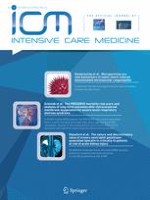Erschienen in:

01.10.2013 | Original
Prevalence and prognosis of cor pulmonale during protective ventilation for acute respiratory distress syndrome
verfasst von:
Florence Boissier, Sandrine Katsahian, Keyvan Razazi, Arnaud W. Thille, Ferran Roche-Campo, Rusel Leon, Emmanuel Vivier, Laurent Brochard, Antoine Vieillard-Baron, Christian Brun-Buisson, Armand Mekontso Dessap
Erschienen in:
Intensive Care Medicine
|
Ausgabe 10/2013
Einloggen, um Zugang zu erhalten
Abstract
Purpose
Pulmonary vascular dysfunction is common during acute respiratory distress syndrome (ARDS), but there is controversy concerning prevalence and prognosis of cor pulmonale during protective ventilation for ARDS.
Methods
This was a prospective observational study in an academic medical intensive care unit in France. Two hundred and twenty-six consecutive patients with moderate to severe ARDS (Berlin definition) ventilated with plateau pressure limited at 30 cmH2O (mean PEEP of 8.8 ± 3.6 cmH2O) underwent transesophageal echocardiography (TEE) within the first 3 days after the diagnosis of ARDS. Cor pulmonale was defined as a dilated right ventricle associated with septal dyskinesia.
Results
Cor pulmonale was detected in 49 patients (prevalence of 22 %; 95 % confidence interval, 16–27 %). Multivariate logistic regression identified infectious causes of lung injury and higher driving pressures as independent factors associated with cor pulmonale. Patients with cor pulmonale exhibited a higher incidence of shock (need for vasoactive drug) at the time of TEE and were more often managed with prone positioning and/or nitric oxide as adjunctive therapy for severe hypoxemia during ARDS course. The 28-day mortality rate was significantly higher in the group with cor pulmonale (60 vs. 36 %, p < 0.01). Multivariate logistic regression identified McCabe and Jackson class, lung injury not related to pneumonia, aspiration, or sepsis, lactic acidosis, driving pressure, and cor pulmonale as independent risk factors for 28-day mortality.
Conclusion
Cor pulmonale occurrence is not negligible in ARDS patients ventilated with airway pressure limitation. Cor pulmonale was associated with sepsis and higher values of driving pressure and was an independent risk factor for 28-day mortality in our series.